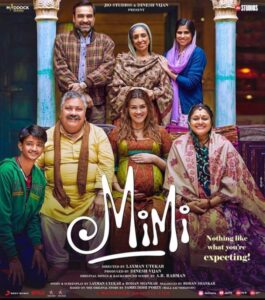Surrogacy is a well-known method of reproduction whereby a woman agrees to become pregnant for the purpose of gestating and giving birth to a child she will not raise but hand over to a contracted party.
Bollywood made many movies on surrogacy concept. The first one, which I watched, was “Chori Chori Chupke Chupke”, in which after the miscarriage of priya (rani mukharji), that couple finds another woman who could conceive child for them. However, this was the type of traditional surrogacy. There was also a movie “Doosri Dulhan” which was released in 1983 that movie also depicts the concept of traditional surrogacy.
Afterward, Bollywood tried to give hand in gestational surrogacy in movies like “I am aafia”, “Badman Gali” “Filhaal” “Good news” etc. but in these movies, they only depicted the Indian surrogacy, where Indians contacted Indian surrogates. But, Mimi showed the concept of medical tourism and commercial surrogacy in India.
When it comes to surrogacy, there are two types: “Traditional” and “Gestational”. Traditional surrogacy is done via artificial insemination, with the surrogate using her own egg and another man’s sperm. Gestational surrogacy is done via In Vitro Fertilization (IVF), Where Fertilized eggs from another woman are implanted into the surrogate’s uterus.
Before we move further, let’s take a look at MIMI’s story-
Mimi is the story of a beautiful young girl “Mimi” (kriti senon) who dances in a hotel to earn money so that she can go to Bollywood and become a heroine. She is quite famous in her locality. But she is worry to have not enough money in comparison to what she needed to get a photoshoot of Dabboo ratnani. One day, Bhanu, a taxi driver (Pankaj tripathi) meets her with an American couple. This couple is in search of a healthy and fit girl who can be the surrogate of their child. They agree to give her 20 lakhs rupees and mimi agrees to take this money to fulfill her dream in Bollywood.
When Mimi conceives the child and is in her last months of pregnancy, that couple refuses to take the child due to a reason. As everyone can expect, Mimi faces a lot hardships and finally abandons her dreams and raise the child. But at the climax of the movie, that couple returns to get back their child.
However, this movie mostly shows the Indian ethical and social values of mother-child relationship rather than discussing the laws of surrogacy. Still, there are some points which this movie raises indirectly.

COMMERCIAL SURROGACY
This movie is about commercial surrogacy, where Mimi charges money from foreign couple to conceive their child. And, Bhanu also takes money as an agent who approached the Mimi for that couple.
In all over the world, there are two systems of surrogacy: “Altruistic surrogacy” and “Commercial Surrogacy”. “Altruistic surrogacy” means the surrogacy in which no charges, expenses, fees, remuneration, or monetary incentive of whatever nature, except the medical expenses, incurred on surrogate mother and the insurance coverage for the surrogate mother, are given to the surrogate mother or her dependents or her representative. In this system, surrogate should be a relative to Intending couple (the couple who need surrogate).
“Commercial Surrogacy” means Commercialization of surrogacy services or procedure including,
- selling or buying human embryo or trading in the sale or purchase of human embryo or gemets or
- selling or buying or trading the services of surrogate motherhood by way of giving payment, reward, benefit, fees, remuneration or monetary incentive in cash or kind, to the surrogate mother or her dependents or her representative, except the medical expenses incurred on the surrogate mother and the insurance coverage for the surrogate mother.
Commercial surrogacy is sometimes referred by potentially offensive terms “wombs for rent”, “outsourced pregnancies” or “baby farms”.
In India, the Supreme court recognized commercial surrogacy in Baby Manji’s case [baby Manji Yamada vs Union of India & Anr (2008)] But the purposed “Surrogacy (Regulation) bill, 2019 (discussed below) bans commercial surrogacy in India and only allowed altruistic surrogacy with strict regulations.
MEDICAL TOURSIM
In past years, India emerged as a hub of medical tourism due to its less expensive treatment and advanced medical facilities. And, with advanced reproductive technology, India is also becoming a popular destination for surrogacy arrangements to many foreigners’ notably rich
westerners. Surrogacy is less expensive in India due to cheap labor and good medical facilities. And that’s the case, couples from mostly developed countries find the option of surrogacy in India.
The business volume of this trade is estimated to be around $ 500 million and the numbers of cases of surrogacy are believed to be increasing at galloping rate. The exact extent of this practice in India is not known, but inquiries revealed that this practice has doubled in last few years and normally women from small towns are selected for this kind of outsourcing pregnancy.[1] This medical tourism related to Surrogacy is also called, “Fertility Tourism”.
These fertility tourists do not all come from Western countries; India is also a popular destination
for medical tourists from Sri Lanka, Pakistan, Bangladesh, Thailand, and Singapore. However, the state of Gujarat is particularly popular, especially among westerners.
Many countries around the world prohibited commercial surrogacy contracts and permitted altruistic surrogacy in limited sense. Due to the restrictiveness of their own countries, desperate couples cross borders into surrogacy-friendly countries, like India, to engage in a surrogacy contract arrangement here.
The fee the couples have to pay the Indian surrogate mother – about a quarter of what mothers in Europe and North-America charge.
In Mimi also, at the beginning of the movie, we see how a person from red light area, contact the couple (intended couple) to show them a perfect girl for surrogacy. And Mimi also accepts the money because she was in dire need of money. These all facts show how Indian women are exploited in the name of surrogacy just for some money.
On average, most Indian surrogate mothers are paid in installments over a period of 9 months. If they are unable to conceive they are often not paid at all and sometimes they must forfeit a portion of their fee if they miscarry. In Mimi, that foreigner couple also pays 20,0000 INR in installments. Mimi was lucky who got such amount of money otherwise generally the average amount which is paid to Indian surrogates is One lakhs to 5 Lakhs.
It may be cited that there is incoherence between the amount quoted by the clinic/hospitals authorities, the commissioning parents who are actually paying, and the surrogate mothers who are at the receiving end. The payments to the surrogate mothers are arbitrarily decided by the infertility physician of the clinic/hospital in all cases. Similarly, there is no clarity about the payments in case if the surrogate mothers were pregnant with twins. It is a normal practice that when the doctor finds out about the twin pregnancy of the surrogate mother, s/he consults the commissioning parents, who in most cases are happy to be parents of twins and want to continue with the pregnancy. Mimi also questioned about the situation If twins or triplicates born and that couple also accepts the situation and agreed to give her extra money in case of twins.

COMMUNICATION BETWEEN SURROGATE MOHTER AND INTENDING COUPLE
Mimi was lucky to have a better communication with the couple as woman did know Hindi language. But in real world, surrogate mothers do not get the chance to meet with couples due to clinics and language barriers. By the end of the first trimester of pregnancy, the commissioning parents are informed, who then visit India to sign the agreement. In most cases this is the first time the surrogate mother gets to meet the commissioning parents.
For the purpose of surrogacy, intending parents were visiting in Indian on “Tourist visa”, so, to regulate such type of activities relating to surrogacy and to facilitate the surrogacy in India, Ministry of Home Affairs announced “medical visa” in December 2012. Through this “Visa”, government tried to ensure adequate management related to surrogacy.
Conditions for Medical visa
Medical Visa may be granted if they fulfil the following conditions: –
- The foreign man and woman are duly married should have sustained at least for two years.
- A letter from the Embassy of the foreign country in India or the Foreign Ministry of the
country should be enclosed with the visa application stating clearly that;- the country recognizes surrogacy and
- the child/children to be born to the commissioning couple through the Indian surrogate mother will be permitted entry into their country as a biological child/children of the couple commissioning surrogate.
- The couple will furnish an undertaking that they would take care of the child/children born through surrogacy.
- The treatment should be done only at one of the registration Assisted Reproductive
Technology clinics recognized by ICMR. (The list of such clinics will be shared with MEA from time to time). - The couple should produce a duly notarized agreement between the applicant couple and the prospective Indian surrogate mother.
If any of the above conditions are not fulfilled, the visa application shall be rejected.
Before leaving India for their return journey, ‘exit’ permission from FRRO/FRO would
be required. Before granting ‘exit’, the FRRO/FRO will see whether the foreign couple is carrying a certificate from the ART clinic concerned regarding the fact the child/children have been duly taken custody of by the foreigner and that the liabilities towards the Indian surrogate mother have been fully discharged as per the agreement. A copy of the birth certificate(s) of the
surrogate child/children will be retained by the FRRO/FRO along with photocopies of the passport and visa of the foreign parents.
For drawing up and executing the agreement cited at (v) above, the foreign couple can be
permitted to visit India on a reconnaissance trip on Tourist Visa, but no samples may be given to any clinic during such preliminary visit.
ABANDONING THE CHILD IN SURROGACY
Abandoning the child due to any problem or difficulty is very inhuman but this happens in many cases, where couple found any abnormality in child or they separated from each other before the birth of child.
In Mimi, Mimi conceived the child but when that couple heard that child could have mental abnormality, they abandon the child and flew for their country. In Mimi, lady doctor also exclaims when she hears the news of child abandoning and says “Oh god! why these people do this”?
Child has to be taken care of by the clinic in case the commissioning parents refuse to or are unable to take care of the former. In some cases, Surrogate mother also keeps the child until a solution has been reached.
In case of abnormality in the child, the child is aborted and the installments given to the surrogate mother are discontinued.
Surrogate motherhood raises difficult ethical, philosophical and social issues, and with the
transaction money the matter complicates even further to look at such an issue from commercial
or business point of view where there is still now no legal provision to safeguard the interest of
the surrogate mother, the child or the commissioning parents in India.
The surrogate mothers are often unaware of their legal rights and due to their financial situation, they cannot afford the services of attorneys. The surrogate may be forced to terminate the pregnancy if so desired by the contracting couple and she will not be able to terminate it if it is against the desire of the couple. No matter, if she could have difficulty in keeping her own baby. There have been instances where the contracting individual has specified the sex of the baby as well, refused to take the baby if it was not normal, and filed a suit against the surrogate saying she had broken the contract.
Denial to handover the baby to intending couple is also a problem in surrogacy. We are “F.R.I.E.N.D.S” generation and we saw how phoebe bufffay feels when she gives the birth of her Brother’s Triplets. Sometimes, Surrogate mothers refuse to handover the baby to intending couple. To curb this situation, Surrogatory clinics handover the child directly to the parents so that surrogate mother could not develop the feelings towards the child. Also, clinics prefer the surrogate mothers to stay in shelter homes far from their homes so that she could not run away with the child, however, Clinics claim that they keep surrogate mothers in shelter homes to give them nutritious food, and better living place and for these shelter home, clinics also charges extra money form intending couples. The other purpose to keep them in shelter home is to to ensure that the surrogate mother doesn’t come in physical contact with her husband which may can increase the risk of her being infected with STDs or even with HIV/AIDS.
Surrogate mothers also choose to live in shelter homes to avoid social stigma which is associated with surrogacy. In Mimi also, Mimi lives with her friend during pregnancy to avoid the question of her parents and society on pregnancy.

COMMERCIAL SURROGACY AND ROLE OF AGENTS
In Reel world, Mimi is approached by an agent Bhanu (panjak tripathi), who meets with couple in his taxi. Bhanu also gets a good commission for his search of perfect surrogate.
In Real-world also, Surrogates mothers are chosen by the agents as the agents themselves live in particular urban clusters for sometimes and observe who are needy and poorest of poor of the section of the section of the community with proven fertility (more than one child) record and target the woman by gaining her confidence as a sympathizer. The agents always showed the rosy side of the picture to the supposed surrogate mother who, most of the time, is a semi-literate person hardly able to sign her name. After handing her over to the clinic, the agents receive a hefty sum as the prize money.
Mimi movie is very successful in showing above facts related to agents and surrogate hunting.
POOR SURROGATE MOTHERS AND POOR SURROGACY LAWS IN INDIA.
At the end of the movie “mimi”, we see how mimi’s family members decide to sell their things to fight the case to keep child. It is pity to see how Indians are suffering and selling their things to fight the case in their own country due to the fault of foreigners.
Whenever, there is a name of case filing, we Indians, start to count years when that case will be completed. Indian judiciary is famous for its late decisions. In this case, it become miserable when a rich foreign couple with well-established clinics threatens to poor surrogate mothers.
Women who are willing to undergo the procedure come from lower middle class backgrounds,
are married, and are in need of money. Mostly, Cases of surrogate mothers are fought through NGOs.
bio-ethicists are concerned that Indian surrogates are being badly paid and working as surrogates in a country with a comparatively high maternal mortality rate.
It is not difficult to have a baby through surrogacy in India because there is no law to control or regulate it. The research findings indicate that in the absence of a concrete law regarding surrogacy arrangement all the three parties involved i.e. the surrogate mother, the commissioning parents and the child are subjected to the whims and caprices of handful of infertility physicians/agencies who gained the most out of this arrangement.
CMR GUIDELINES
To curb the irregularities in surrogacy, the Indian Council of Medical Research (ICMR) published guidelines in 2006, for accreditation, supervision and regulation of ART clinics in India.
Below are the main points from these guidelines:
- DNA tests are compulsory to determine that the intended parents are indeed the genetic
parents. If this is not the case the child must be adopted instead. - Surrogacy should normally only be an option for patients for whom it would be
physically or medically impossible/ undesirable to carry a baby to term. - The payments received by the surrogate mothers should be documented and cover all
genuine expenses associated with the pregnancy. - The responsibility of finding a surrogate mother should rest with the couple, or a semen
bank, not the clinic. - A surrogate mother should not be over 45 years of age.
- The ART clinic should ensure possible surrogate woman satisfies all the testable criteria to go through a successful full-term pregnancy.
- No woman may act as a surrogate more than three times in her lifetime.
- The surrogate mother must declare that she will not use drugs intravenously, and not
undergo blood transfusion excepting of blood obtained through a certified blood bank. - A relative, a known person, as well as a person unknown to the couple may act as a
surrogate mother for the couple.
But these guidelines have not legal weight so these are mostly ignored by the clinics.
THE SURROGACY (REGULATION) BILL, 2019
There has been a plethora of reports concerning unethical practices, abandonment of children, exploitation of surrogate mothers, death of the surrogate mother, rackets of intermediaries in importing, exporting and selling of human embryos and gametes and unregularised clinics practicing Surrogacy.
The Law Commission of India has, in its 228th Report (2009) recommended for prohibition of commercial surrogacy by enacting a suitable legislation. Lack of legislation to regulate surrogacy is the main reason of unethical practice by clinics, misuse of surrogate mother and rampant commercialization.
To regulate the surrogacy services in the country, the Surrogacy (Regulation) Bill, 2019 was prepared and presented in loksabha, loksbha passed the bill but this bill is still waiting to go in Rashtrapati Bhawan form Rajye Sbha.
Here are some important features of Surrogacy (Regulation) Bill-
- No surrogacy clinic, unless registered under this Act, shall conduct or associate with, or help in any manner, in conducting activities relating to surrogacy and surrogacy procedures.
- No surrogacy clinic, shall advertise the commercial surrogacy, hiring and selling the services of surrogate mothers.
- No surrogacy clinic will conduct sex selection for surrogacy.
- Surrogacy services will be availed only in following cases-
- when either or both members of the couple is suffering from proven infertility;
- when it is only for altruistic surrogacy purposes;
- an order concerning the parentage and custody of the child to be born through surrogacy, has been passed by a court of the Magistrate of the first class or above, on an application made by the intending couple and the surrogate mother; and
- an insurance coverage in favour of the surrogate mother for a period of sixteen months covering postpartum delivery complications from an insurance company or an agent recognised by the Insurance Regulatory and Development Authority established under the Insurance Regulatory and Development Authority Act, 1999;
- the surrogate mother is in possession of an eligibility certificate issued by the appropriate authority on fulfilment of the following conditions,
- Intending couple is in possession of an eligibility certificate.
- Surrogacy certificate to surrogate mother will be issued if she is the age of 25 to 35 and closed relative to intending couple and married with one child of her own. A woman shall not act as surrogate mother more than once in her life time.
- Eligibility certificate to intending couple will be issued if couple is between 23 to 50 years in case of female and between 26 to 55 years in case of male on the day of Certification and are married for at least five years and are Indian citizens; the intending couple should not have any surviving child biologically or through adoption or through surrogacy earlier.
- The surrogate mother shall have an option to withdraw her consent for surrogacy before the implantation of embryo in her womb.
- The intending couple shall not abandon the child, born out of a surrogacy procedure,
- whether within India or outside, for any reason whatsoever. And, child born out of surrogacy procedure, shall be deemed to be a biological child of the intending couple and the said child shall be entitled to all the rights and privileges available to a natural child under any law for time being in force.
This bill marks the full stop on Commercial Surrogacy and only allows altruistic surrogacy for Indian citizens. Probably, this could be the reason that bill is still pending in Rajye sabha as it ends one of the most important parts of medical tourism.
Indian is becoming the popular destination for surrogacy in all over the world and still, there is no regulation on surrogacy. Probably, this could be the worst thing of this industry.
Coming back to the movie “Mimi”, people can criticise this movie but still this movie tries to portray the system, social behaviour, and tendencies in surrogacy. And if you want to know the above facts and tendencies of surrogacy system, this movie will tell you in humours and emotional way.
REFERENCES
- The surrogacy (Regulation) bill, 2019
- Baby Manji Yamada v. Union of India, (2008)
- Centre for Social Research,Report: Surrogate Motherhood Ethical or Commercial
[1] ‘Surrogate mothers: Outsourcing pregnancy in India’ article by Joseph Gothia, 26th June 2008, link:
http://india.merinews.com/cat Full.jsp?articleID= 136421
This article is written by Advocate A.H. Gangohi.

Very well explained and valuable information by writer. Keep it up